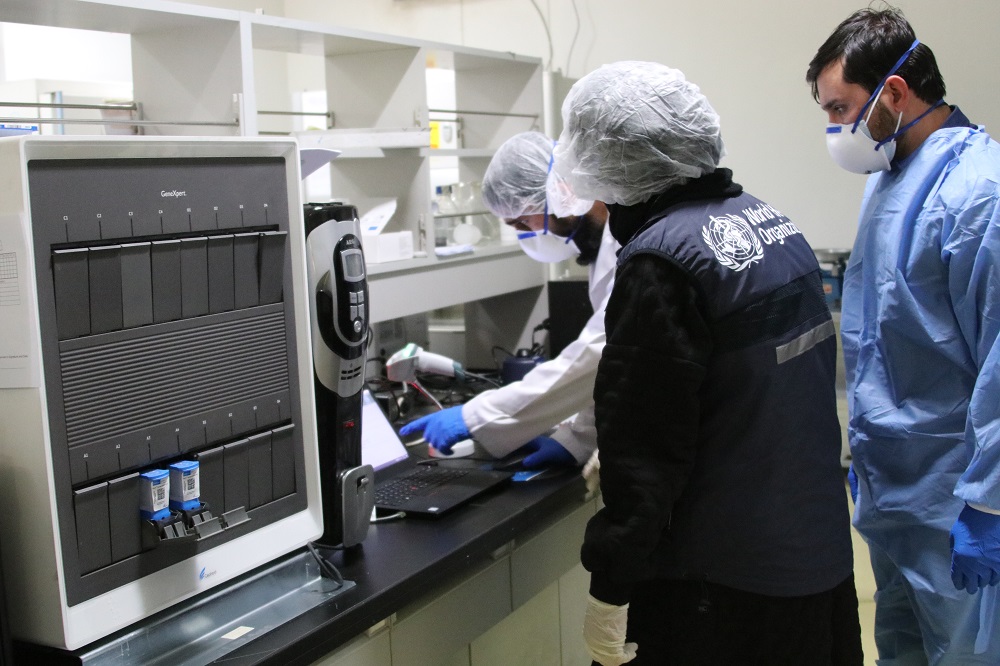 WHO works with partners to scale up the COVID-19 prevention and response, including expanding testing, enhancing surveillance and diagnostics of COVID-19, and helping provincial hospitals and facilities improve case management and infection control. Credit: WHO Afghanistan
WHO works with partners to scale up the COVID-19 prevention and response, including expanding testing, enhancing surveillance and diagnostics of COVID-19, and helping provincial hospitals and facilities improve case management and infection control. Credit: WHO Afghanistan
19 September 2022 – With the support of the World Health Organization (WHO)’s Regional Office for the Eastern Mediterranean, 21 countries in the Region now have domestic genome sequencing capacity – a critical tool for understanding severe acute respiratory coronavirus-2 (SARS-CoV-2) and its variants of concern along with other emerging pathogens’ evolution and circulation.
Since the onset of the COVID-19 pandemic, the Regional Office has been providing constant support to countries by supplying advanced genomic sequencing machines, training the health workforce in bioinformatics and genomics, boosting financial resources, and ensuring the availability of reagents and other essential supplies.
These efforts have borne fruit, as 11 of the Region’s countries have built their capacity to undertake routine genomic surveillance from scratch, in response to the public health impact of COVID-19 across the Region.
Even in countries where genomic sequencing was not available at the onset of the pandemic, the Regional Office provided logistical support to ship samples for sequencing abroad to WHO’s regional collaborating centres. This crucial support was made accessible to 10 laboratories in 9 countries.
“Our Region has so far reported over 23 million confirmed COVID-19 cases with nearly 348 117 associated deaths. The pandemic is far from over, and we are still receiving daily reports of cases and deaths,” said Dr Richard Brennan, WHO’s Regional Emergency Director for the Eastern Mediterranean. “Without strengthened surveillance and genomics, we won’t be able to identify or track the next wave or emergence of new variants. Quite simply, better genomic sequencing allows us to understand and monitor the virus, and target our disease control measures more accurately,” he added.
Why genomic surveillance is important
The significance of genomic surveillance – which has also proven vital in managing the spread of monkeypox – goes beyond COVID-19 detection, as it also enables the continuous monitoring of pathogens along with the analysis of their genetic similarities and differences. This helps researchers, epidemiologists and public health officials monitor the evolution of infectious disease agents, signal alerts on the spread of pathogens, and develop countermeasures such as vaccines.
The arrival of COVID-19 worldwide and in the Region increased the pace of strengthening genomic surveillance. Accordingly, it became a top priority in WHO’s response agenda to play an instrumental role in detecting, identifying and understanding the evolution, mutations and genomic diversity of the SARS-CoV-2 virus.
WHO unveils a global genomic surveillance strategy (2022–2032)
In March 2022, WHO released a global 10-year unifying framework to strengthen country, regional, and global genomic surveillance not specific to a single pathogen or disease threat. The strategy aims to link and embed robust pathogen monitoring within broader surveillance systems, identify opportunities to strengthen and establish capacities and systems and bring partners and stakeholders together to work on a common vision. The strategy lists 5 substantial objectives that will support the achievement of the overall goal.
Countries of the Region: leading by example
Following the significant increase in molecular diagnostic capacity for SARS-CoV-2 in the country, enabling up to 250 000 tests per day, the National Influenza Centre at the Ministry of Health in Morocco recognized early on that the need for SARS-CoV-2 sequencing was also increasing. To address this, Morocco set up a national consortium of 4 laboratories – 2 public and 2 private – to cover different geographic regions in the country.
In Oman, the Ministry of Health's Central Public Health Laboratory serves as WHO’s regional reference laboratory for COVID-19. The Laboratory collaborated with national and local academic partners to strengthen workforce capacities, increase national genomic surveillance coverage, and develop algorithms for selecting cases for sequencing so that virological trends associated with different sub-populations such as travelers, severely ill patients, and cases from different geographic regions could be well understood.
In Saudi Arabia, a massive effort was undertaken to expand genomic surveillance – so that the viral phylodynamics could be understood in all geographic regions of the country – and to look at patterns among severe cases, travel-related cases, post-vaccination cases, and re-infections.
Sudan is the only remaining country in the Region that is still receiving support from other regional and international referral laboratories. WHO will continue to strengthen regional and national sequencing capacities by extending technical support to the countries in the Region, and also advocating the sustainability of these capacities in the short and medium term.
“We have all invested in national genomic sequencing, and it is impressive to have reached this milestone,” said Dr Abdinasir Abubakar, Programme Manager, Infectious Hazard Preparedness Programme, WHO Regional Health Emergencies Programme. “Through this vital tool, we will be able to formulate a clearer understanding and draw accurate conclusions of where a virus is spreading and how it is evolving. Therefore, we urge countries to capitalize on this achievement by maintaining testing and sequencing services.”
Related links
Global genomic surveillance strategy for pathogens with pandemic and epidemic potential 2022–2032





